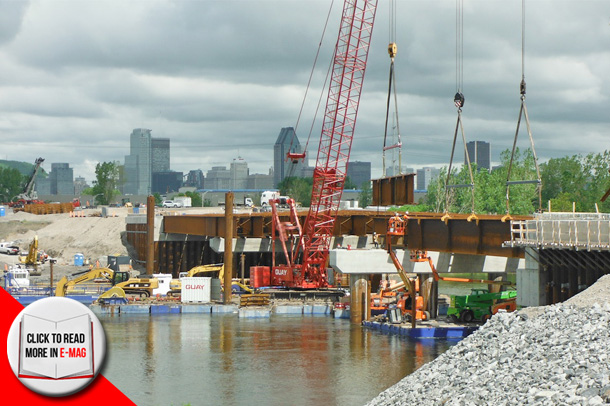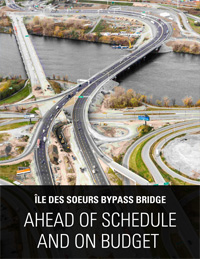Ahead of schedule and on budget
By Cheryl Long
When the Île des Soeurs temporary bypass bridge in Verdun, Quebec opened to traffic in October this year, it marked a truly significant occasion. Not only was access to the bridge a relief for Greater Montreal commuters, but that phase of the project – transferring traffic to the bypass bridge – was completed approximately five months ahead of schedule.
The project has been managed by Jacques Cartier and Champlain Bridges Incorporated (JCCBI), a publicly-funded Crown corporation reporting to Infrastructure Canada. The temporary bypass bridge would allow traffic to be diverted during the reconstruction of the original Île des Soeursbridge, slated for completion in 2020. It’s part of the larger new bridge for the St. Lawrence Corridor Project that will eventually see the bridge span the St. Lawrence River.
Catherine Tremblay, Principal Director, Project, Construction and Operations for JCCBI, is a civil engineer and has spent most of her career working in infrastructure in the hydroelectric sector. She explained that JCCBI received a mandate to build the temporary bridge while Infrastructure Canada worked on the full corridor project. Operating within a $125 million budget, the organization had approximately two years to perform engineering and environmental assessments, complete the actual construction process and then wrap up final details. Not only did they beat an important deadline by several months, but Tremblay said the project is going to come in at less than $100 million, well under budget.
“It was a very fast track project. We were given the mandate in July 2012, the engineering mandate started in September 2012 and we went on this (project) from May or early June 2013,” Tremblay said. “In terms of engineering and environmental assessment, it was very, very fast tracked.”
Credit goes to the “A-team”
Tremblay credits the teams behind the project for much of its success. Both the engineering and environmental assessments were conducted by professional services firm WSP (formerly Genivar) and the construction portion was awarded to EBC-Pomerleau. “I would say we had the A-team there. They were very dedicated; they understood we were on a tight schedule and they worked with us to make sure that we (met) this goal.”
What worked to everyone’s advantage was the location of the temporary bridge, downstream from the original structure. Since it was being built in a fairly isolated area, disturbances to the public were minimized and any major work that would affect traffic was carried out during weekend blitzes, lessening the impact on daily commuters. It also allowed the original bridge to remain operational, which was crucial for local motorists.
The project had a potentially large environmental impact. It was being built on a former landfill site, it was going to affect the area’s fish habitat and it would risk the local population of brown snakes. In addition, because the landfill soil was compressible, preliminary investigations had to ensure that the new roadway wouldn’t shift as traffic moved across the bridge. It took a great deal of ingenuity to overcome the physical restrictions posed by the site while keeping the rest of the projecton track, Tremblay said.
Offshoot project recreates fish habitats
Constructing the bridge bypass was going to result in the loss of close to 5,000 square metres of fish habitat. An offshoot project that involved the building of a breakwater was launched to encourage growth in the fish population in the Îles de la Paix National Wildlife Area in Lake Saint-Louis. Completed in June 2013, the breakwater is designed to protect the habitat from erosion caused by waves, which promotes the creation of fish habitats. Part of the project’s environmental component also included removing brown snakes, considered an endangered species, from the construction area and transferring them to another location on Île des Soeurs. When the team went back to check on the snakes in the spring of 2014, they were able to locate about one-third of the population. The successful relocation effort is being recorded in a scientific article to be used in future development projects.
The bridge bypass project has become an example of the ideal marriage between engineering and environmental departments as they worked together to finish on time and on budget, while respecting the environment.
In December, JCCBI will meet another project milestone when the new dedicated bus lane opens. The addition expands the bridge to seven lanes – six regular lanes and one lane for buses. In the past, travellers have been accustomed to the number of lanes going down to five on the Île des Soeurs Bridge in the afternoon since one would be limited to buses. The dedicated bus lane adds fluidity to the traffic flow, Tremblay said.
In addition, the new lane eliminated the need for a traffic light on the A-15 that allowed buses to enter the bridge’s dedicated lane during rush hour, causing evening congestion. Pedestrians and cyclists have also benefitted from the project with the widening of a multi-functional path designed for non-motorists.
The project’s final details, some of which have to wait until spring, are expected to be completed by June 2015. To learn more about the project, visit jccbi.ca or champlainbridge.ca.







